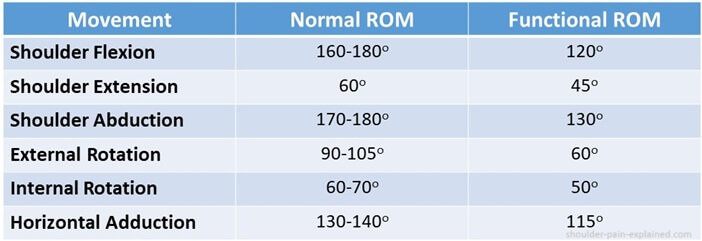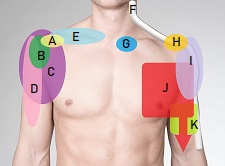- Home
- Shoulder Anatomy
- Shoulder ROM
Shoulder Range Of Motion
Written By: Chloe Wilson BSc (Hons) Physiotherapy
Reviewed By: SPE Medical Review Board

Shoulder range of motion essentially refers to how far you can move your shoulder in different directions.
The shoulder is the most mobile joint in the whole body but that also makes it prone to injury which can lead to stiffness and weakness.
This can impact day to day activities, and may limit what you can do.
For the shoulder to move properly, there needs to be good range of motion both at the shoulder joint and the shoulder blade, as well as good strength and flexibility in all the shoulder muscles.
Here, we look at the different types of shoulder range of movement, the normal range of motion in each direction, what range of needed for different functional activities, what limits movement and how to measure and increase shoulder range of motion.
What Is Shoulder Range Of Motion?
The shoulder is the most mobile joint in the whole body and can move in lots of different directions. The different types of shoulder motion are:
- Flexion: lifting the arm forwards above your head aka shoulder elevation through flexion
- Extension: moving the arm backwards
- Abduction: lifting the arm out to the side and up above your head aka shoulder elevation through abduction
- Adduction: bringing the arm across the body at waist height
- External Rotation: twisting your arm outwards aka lateral rotation
- Internal Rotation: twisting your arm inwards aka medial rotation
- Horizontal Adduction: bringing your arm across the front of your body at shoulder height
Shoulder range of motion may be classified as:
- Active ROM: how far the shoulder can move on its own i.e. shoulder muscles actively working without any external help
- Passive ROM: how far the shoulder can be moved by an external force, typically another person i.e. the shoulder muscles are completely relaxed
In a normal, healthy shoulder, active and passive motion with be very similar with slightly more passive range than active.
However, if you have injured your shoulder, have an underlying shoulder condition or are in pain, then you may have limited shoulder range of motion, particularly active ROM.
What Is Normal Shoulder Range Of Motion?
Normal shoulder range of motion is typically
- Shoulder Flexion: 160-180o
- Shoulder Extension: 60o
- Shoulder Abduction: 170-180o
- Shoulder Adduction: 30-50o
- External Rotation: 90-105o
- Internal Rotation: 60-70o
- Horizontal Adduction: 130-140o
Shoulder range of motion relies on a complex co-ordination of movement at the shoulder and shoulder blade, often in multiple directions to allow for full movement.
On a day to day basis, we don’t typically need full active or passive range of motion to be able to perform a majority of our daily tasks e.g. washing, dressing, opening door and jars, lifting and carrying objects.
The amount of functional range of motion needed at the shoulder for most activities is typically:
- Shoulder Flexion: 120o
- Shoulder Extension: 45o
- Shoulder Abduction: 130o
- External Rotation: 60o
- Internal Rotation: 50o
- Horizontal Adduction: 115o
This means that you can still perform most daily activities even if you have lost around 30% of shoulder ROM.

What Affects Shoulder Range Of Movement?
Range of motion in the shoulder will vary slightly depending on:
- Age: shoulder range of movement gradually decreases with age
- Gender: women usually have slightly greater ROM in their shoulders than men
- Hand Dominance: the shoulder of the dominant hand is usually slightly more flexible than the non-dominant arm with increased range of flexion, abduction and external rotation, but slightly decreased internal rotation
But the biggest impact on shoulder range of motion is an injury or condition which causes pain and restriction such as:
- Frozen Shoulder: reduces rotation (external more than internal) and flexion
- Impingement Syndrome: reduces abduction, often with a painful arc where the pain is worse between 60-120o of abduction
- Tendonitis: can reduce range in any direction depending on which tendon is affected e.g. biceps tendonitis may reduce active flexion
- Rotator Cuff Tear: weakness with abduction and external rotation
- ACJ Problem: reduced horizontal adduction
- Fracture: likely to reduce range of motion in shoulder in all directions, depending on the severity of the break
- Muscle Tightness Or Weakness: can reduce range in any direction depending on which shoulder muscle is affected
If your shoulder range of movement is reduced in any direction, it is important to see your doctor to get an accurate diagnosis so you can get the right treatment.
#CommissionsEarned from Amazon on qualifying purchases
How To Treat Shoulder Limited Range Of Motion
Improving movement will depend on what has limited shoulder range of motion in the first place but will usually involve a combination of:
- Medication: pain relief e.g. paracetamol/Tylenol and/or non-steroidal anti-inflammatories e.g. ibuprofen/Advil to reduce pain and inflammation
- Shoulder Range Of Motion Exercises: Shoulder stretches and strengthening exercises will help to improve strength, flexibility and control. Scapular stabilisation exercises are also important as the help control the position and motion of the shoulder blade which can have a big impact of shoulder movement
- Heat/Ice: using ice or heat can help to improve range of motion in the shoulder. Ice packs tend to work best in the early stages after acute injuries to reduce pain and swelling whereas heat pads tends to work better with more chronic problems by improving circulation and flexibility
- Joint Mobilisations: Manual techniques such as joint mobilisations and tissue stretches performed by a physical therapist can be a really helpful way to treat limited shoulder range of motion. They help to restore the natural glide, spin and roll movements at the shoulder to free up movement. Joint mobilisations should always be combined with shoulder range of motion exercises to prevent the structures from tightening up again
- Keep Active: our bodies are designed to be used, and keeping active and healthy helps to ensure good joint health. Regular exercise such as cycling, swimming or jogging can help prevent joint stiffness and muscle weakness/tightness
How To Measure Shoulder ROM
The most accurate way to measure shoulder range of motion is to use a goniometer. A goniometer looks like a circular protractor with two arms coming out of it.
In the middle of the circular part (axis) you’ll find a full 360o arc measured out. There are two arms, one which extends directly out of the circular part (static arm) and a moveable arm which sits on top.
You will place the goniometer in a slightly different place depending on which movement you are measuring. It is very hard to take an accurate goniometer measurement yourself, you will need to get someone else to help.
Shoulder Flexion/Extension ROM
Measure from the side of the body, starting with your arm by your side

- Static Arm: parallel with the trunk
- Axis: middle of shoulder joint
- Movement Arm: in line with the middle of the humerus/lateral epicondyle elbow
Flexion: With the thumb pointing forwards, bring the arm forwards and up above your head. Watch that the rib cage/trunk doesn’t lift up. Normal shoulder flexion range of motion is 0-180o
Extension: take the arm straight back behind you, leading with the little finger. Again, watch that the trunk doesn’t bend forwards. Normal shoulder extension range of motion is 0-60o
Shoulder Abduction ROM

Measure from the front, either lying down or standing up:
- Static Arm: parallel to the sternum/trunk
- Axis: middle of shoulder joint, over head of humerus
- Movement Arm: in line with the middle of the humerus
With the thumb pointing out to the side, bring the arm out and up above your head (leading the movement with your thumb). Normal shoulder abduction range of motion is 0-180o
Shoulder Rotation ROM
Lying on your back, arm out to the side (90o abduction), elbow bent 90o, hand pointing to ceiling

- Static Arm: perpendicular to the ceiling (pointing straight upwards)
- Axis: Olecranon process at the elbow
- Movement Arm: in line with ulnar styloid process
Internal Rotation: bring the hand/forearm forwards towards the floor (don’t let the shoulder lift up). Normal shoulder internal rotation is 0-70o
External Rotation: take the hand/forearm backwards towards the floor. Normal shoulder external rotation is 0-105o
Other Ways To Measure
If you don’t have access to a goniometer, there are other ways you can measure shoulder range of motion. They may be slightly less accurate but they give useful feedback and help you keep track of changes.
- Guesstimate: You can eye ball to estimate the range of motion in the shoulder. Many physios will do this rather than using a goniometer. There is often a high measurement discrepancy between individuals but you can reduce the error by always having the same person doing the estimating.
- Phone App: There are various phone apps out there for Apple and Android that can be used to measure shoulder range of motion, two of the most popular being “Reflex Shoulder” on Apple and “PhysioMaster: Physical Therapy” on Android
- Photos: take a photo of yourself at the end range of each movement and then measure the angles as described above
Range Of Motion In Shoulder Summary
Shoulder range of motion refers to how far the shoulder can move in different directions.
The main movements at the shoulder are flexion, extension, abduction, adduction, internal and external rotation and horizontal adduction.
There are two types of shoulder range of motion, active and passive. Functional shoulder range of motion refers to how much movement is required to perform most daily activities and tends to be about 30% less than normal full shoulder range of movement.
Limited shoulder range of motion is typically due to shoulder injuries or conditions such as impingement syndrome, rotator cuff tears, bursitis or tendonitis.
Limited shoulder range of motion can usually be improved with a combination of medication, shoulder range of motion exercises, ice, heat and physical therapy.
You may be interested in the following articles:
- Front Shoulder Pain
- Pain On Top Of Shoulder
- Pain Behind The Shoulder
- Shoulder Clicking & Grinding
- Shoulder, Arm & Hand Pain
- Burning Shoulder Pain
- Elbow Range Of Motion
Related Articles
Medical & Scientific References
- Shoulder Range Of Movement. FP Notebook
- An Analysis Of Functional Shoulder Movements During Task Performance Using Dartfish Movement Analysis Software. International Journal Of Shoulder Surgery
- Shoulder Range Of Movement In The General Population: Age And Gender Stratified Normative Data Using A Community-Based Cohort. BMC Musculoskeletal Disorders
- Concept And Simulation Of An Alternative Design For An Orthopaedic Shoulder Implant. Journal Of Medical Engineering & Technology
- Shoulder Structure And Function: The Impact Of Osteoarthritis And Rehabilitation Strategies. Journal Of Hand Therapy
Page Last Updated: November 12th, 2024
Next Review Due: November 12th, 2026



